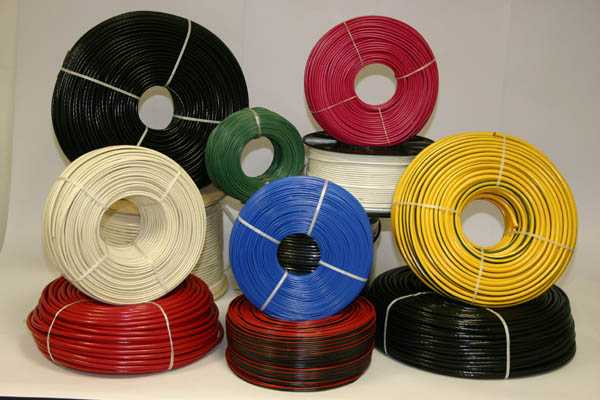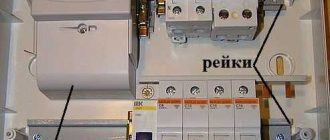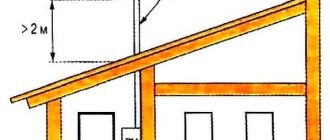When installing electrical wiring, you need to know which cross-section of cable you need to install. The cable cross-section can be selected either by power consumption or current consumption. Also take into account the length of the cable and the method of laying.
Treść artykułu
Choosing the cross-section of the cable by power
Select the cross-section of the wire can be selected by the power of devices that will be connected. These devices are called load and the method can still be called “by load”. The essence of it from this does not change.

Collecting data
To begin with, find in the passport data of household appliances consumed power, write it out on a piece of paper. If it is easier, you can look at the nameplates – metal plates or stickers attached to the body of appliances and equipment. There is basic information and, more often than not, the wattage is present. It is easiest to recognize it by the units of measurement. If the product is made in Russia, Belarus, Ukraine, usually stands the designation W or kW, on equipment from Europe, Asia or America is usually the English designation of watts – W, and the power consumption (you need it) is denoted by the abbreviation “TOT” or TOT MAX.
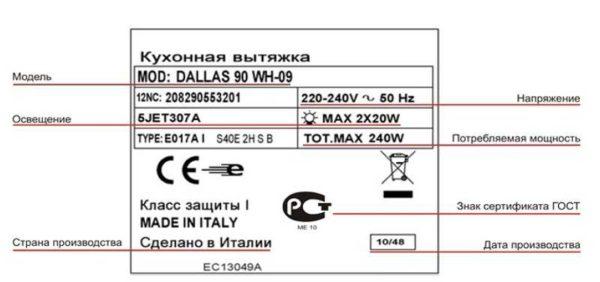
If this source is also unavailable (the information has faded, for example, or you are just planning to buy a technique, but have not yet decided on the model), you can take the average statistical data. For convenience, they are summarized in a table.
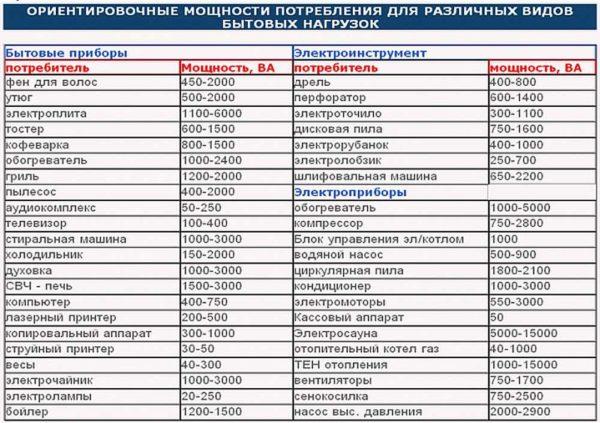
Find the technique that you plan to put, write out the power. It is sometimes given with a large scatter, so that sometimes it is difficult to understand what figure to take. In this case, it is better to take the maximum. As a result, when calculating you will have a slightly overestimated power of the equipment and will need a cable with a larger cross-section. But it is good for calculating the cable cross-section. Only cables with a smaller cross-section than necessary burn. Cables with a larger cross-section work for a long time, because they heat less.
The essence of the method
To pick up the cross-section of the wire on the load, add up the power of devices that will be connected to this conductor. It is important that all powers were expressed in the same units of measurement – either in watts (W), or in kilowatts (kW). If there are different values, bring them to a single result. To convert, kilowatts are multiplied by 1000 to get watts. For example, let’s convert 1.5 kW into watts. This would be 1.5 kW * 1000 = 1500 watts.
If necessary, you can do the reverse conversion – convert watts into kilowatts. For this purpose, we divide the figure in watts by 1000 and get kW. For example, 500 W / 1000 = 0.5 kW.
Next, in fact, begins the choice of cable cross-section. Everything is very simple – we use the table.
| Cable cross-section, mm2 | Conductor diameter, mm | Copper wire | Aluminum wire | ||||
| Current, A | Power, kW | Current, A | Power, kW | ||||
| 220 В | 380 В | 220 В | 380 В | ||||
| 0,5 mm2 | 0,80 mm | 6 А | 1.3 kW | 2,3 kW | |||
| 0,75 mm2 | 0,98 mm | 10 А | 2.2 kW | 3.8 kW | |||
| 1.0 mm2 | 1,13 mm | 14 А | 3.1 kW | 5.3 kW | |||
| 1.5 mm2 | 1.38 mm | 15 А | 3.3 kW | 5.7 kW | 10 А | 2.2 kW | 3.8 kW |
| 2.0 mm2 | 1.60 mm | 19 А | 4.2 kW | 7,2 kW | 14 А | 3.1 kW | 5.3 kW |
| 2.5 mm2 | 1.78 mm | 21 А | 4.6 kW | 8,0 kW | 16 А | 3.5 kW | 6.1 kW |
| 4.0 mm2 | 2,26 mm | 27 А | 5.9 kW | 10,3 kW | 21 А | 4,6 kW | 8.0 kW |
| 6.0 mm2 | 2.76 mm | 34 А | 7.5 kW | 12,9 kW | 26 А | 5.7 kW | 9.9 kW |
| 10.0 mm2 | 3.57 mm | 50 А | 11.0 kW | 19,0 kW | 38 А | 8,4 kW | 14,4 kW |
| 16.0 mm2 | 4,51 mm | 80 А | 17.6 kW | 30,4 kW | 55 А | 12.1 kW | 20.9 kW |
| 25.0 mm2 | 5.64 mm | 100 А | 22.0 kW | 38,0 kW | 65 А | 14,3 kW | 24.7 kW |
To find the required cable cross-section in the appropriate column – 220 V or 380 V – find the figure that is equal to or slightly higher than the power we calculated earlier. The column is chosen based on how many phases are in your network. Single-phase – 220 V, three-phase 380 V.
In the line found, we look at the value in the first column. This will be the required cable cross-section for this load (consumed power of appliances). Cable with cores of such cross-section and you will need to look for.
A little about whether to use copper wire or aluminum. In most cases, when laying wiring in a house or apartment, use cables with copper conductors. Such cables are more expensive than aluminum, but they are more flexible, have a smaller cross-section, it is easier to work with them. But, copper cables with a large cross-section, no more flexible than aluminum. And under heavy loads – at the entrance to the house, in an apartment with a large planned power (from 10 kW and more) it is advisable to use a cable with aluminum conductors – you can save a little.
How to calculate cable cross-section by current
You can pick up the cross-section of the cable by current. In this case, we do the same work – collect data on the connected load, but look for the maximum current consumption in the characteristics. Having collected all the values, summarize them. Then we use the same table. Only we look for the nearest higher value in the column signed “Current”. In the same line we look at the cross-section of the wire.
For example, we need to connect a cooktop with a peak current consumption of 16 A. We will lay copper cable, so look in the appropriate column – the third from the left. Since there is no value of exactly 16 A, we look in the line 19 A – this is the nearest larger. The suitable cross-section is 2.0 mm2. This will be the minimum value of the cable cross-section for this case.
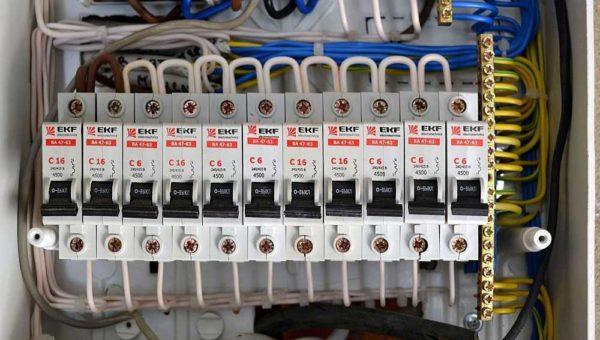
Pay attention not to the line with a slightly lower value can not. In this case, at maximum load, the conductor will be very hot, which can lead to the fact that the insulation will melt. What can happen next? The automatic protection device can work, if it is installed. This is the most favorable variant. Household appliances may fail or a fire may start. Therefore, always choose the cross-section of the cable by a larger value. In this case, you can later install equipment even slightly higher in power or current consumption without rewiring.
Calculation of cable power and length
If the power line is long – several tens or even hundreds of meters – in addition to the load or current consumption, it is necessary to take into account the losses in the cable itself. Usually large distances of power lines when introducing electricity from the pole into the house. Although all data should be specified in the project, you can reinsure and check. To do this, you need to know the allocated power to the house and the distance from the pole to the house. Then according to the table, you can pick up the cross-section of the wire, taking into account the length losses.
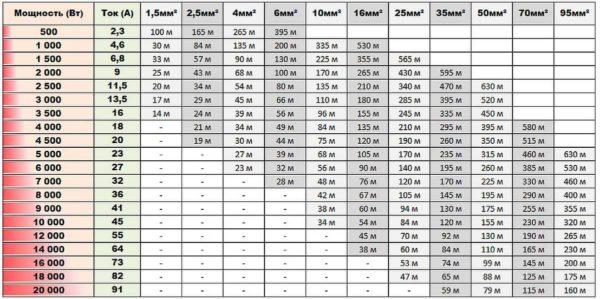
In general, when laying electrical wiring, it is always better to take some reserve for the cross-section of wires. First, with a larger cross-section will be less heated conductor, and therefore the insulation. Secondly, in our lives there are more and more devices that work from electricity. And no one can guarantee that in a few years you will not need to put a couple of new devices in addition to the old ones. If there is a reserve, you can just plug them in. If there isn’t, you’ll have to get wise – either change the wiring (again) or make sure you don’t turn on powerful appliances at the same time.
Open and closed wiring
As we all know, when current flows through a conductor, it heats up. The greater the current, the more heat is generated. But, when passing the same current through conductors with different cross-sections, the amount of heat released varies: the smaller the cross-section, the more heat is released.
In this connection, when conductors are laid open, its cross-section can be smaller – it cools down faster, as the heat is transferred to the air. In this case, the conductor cools down faster, the insulation does not deteriorate. In case of closed laying the situation is worse – the heat is dissipated more slowly. Therefore, for closed laying – in cable ducts, pipes, in the wall – it is recommended to take a cable of larger cross-section.
The choice of cable cross-section taking into account the type of its laying can also be carried out with the help of the table. The principle has been described before, nothing changes. Just one more factor is taken into account.
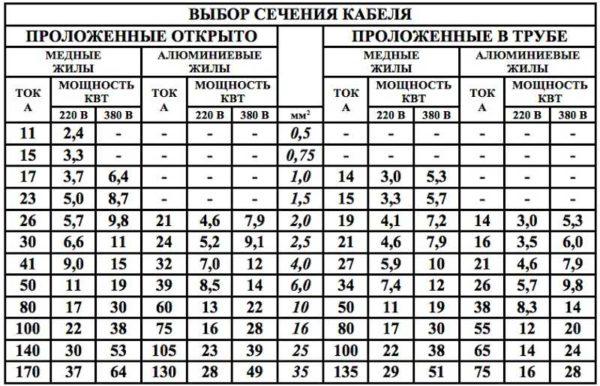
And lastly, a few practical tips. Going to the market for a cable, take with you a caliper. Too often, the declared cross-section does not coincide with the reality. The difference can be 30-40%, which is a lot. What’s your risk? Burnout of the wiring with all the consequences. Therefore, it is better to check on the spot whether this cable really has the required cross-section of the core (diameters and corresponding cable cross-sections are in the table above). You can read more about determining the cable cross-section by its diameter here.

